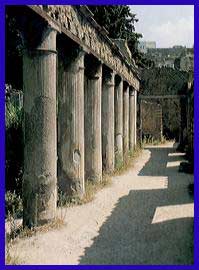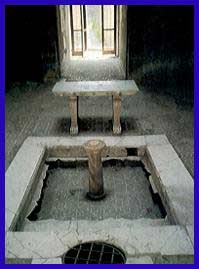|
 As far as we know ,
Herculaneum was an italic city founded around the IVth century B.C. coping,
in the geometric regularity of his structures, the lay-out of Naples, to see how
the "decumani" (the main streets, with an east-west orientation) and
the "cardines" (narrower streets) identify with those of the
Partenopean city. As far as we know ,
Herculaneum was an italic city founded around the IVth century B.C. coping,
in the geometric regularity of his structures, the lay-out of Naples, to see how
the "decumani" (the main streets, with an east-west orientation) and
the "cardines" (narrower streets) identify with those of the
Partenopean city.
There is undeniably a "feeling" about Herculaneum which is quite
different from what one "feel" in other ancient world centres brought
to light so far, including Pompeii.
To a large extent this is due to the special circumstances of its interment by
Vesuvius during the eruption of 79 A.D.
The city was not struck by ashes and lapilli, but by a torrent of mud flooding
down from the slopes of the volcano. Having solidified and becoming tufalike, it
constituted for centuries the best possible defence against atmospheric
agents and against illegal excavators.
excavators.
Towards the end of the first century B.C. the town become a resort center for
the Roman aristocracy. Unlike Pompeii, Herculaneum seems a more peaceful town,
especially devoted to navy and fishing with a lot of greenery and vineyards. It
is said, in fact, that Herculaneum was Epicure's favorite place for his
philosophical studies.
Herculaneum had four to five thousands inhabitants and its square measure was a
fifth smaller that of Pompeii.
It was destroyed by the 79 A.D. eruption.
Herculaneum seems more elegant and refined than Pompeii because of the original
character of architecture and decoration (ornaments) and because of the natural
position above the scenary of the gulf.
Excavations began in 1709, while from 1738 to 1765 systematic explorations were
conducted by order of Charles III of Bourbons.
From 1927 the excavations in the open of the whole area were begun by Amedeo
Maiuri.
The
Casa d'Argo (Argus'House) with two floor, a garden surrounded by a
portico with columns;
The
Casa dell'atrio a mosaico (House with a mosaic atrium) large edifice
with a 'tablino' (living room), a garden,
terraces and some halls with rich paintings;
The
Casa del tramezzo di legno (the House with a wood partition) with a huge
atrium decorated with frescos;
The
Casa Sannitica (the Sannitic House) a kind of pre-roman construction with a
wonderful atrium and some rooms with fine frescos ;
 The
Terme (the thermal baths) divided in male and female, a huge complex of
gymnasiums, dressing-rooms, swimming pools and some halls with mosaic floor; The
Terme (the thermal baths) divided in male and female, a huge complex of
gymnasiums, dressing-rooms, swimming pools and some halls with mosaic floor;
The
Casa di Nettuno e Anfitrite (the Neptune and Amphitryte's House) with
a nice nympheus covered by a colourful mosaic . This house shows us a shop with
amphorae that is the best preserved shop of the ancient world;
The
Palestra (the gymnasium) with big halls closed by porticos and a large
basin with a beautiful bronze fountain;
The
Casa dei Cervi (the deer's house) a rich edifice with an atrium and a
triclium , in which we can admire the wonderful marmorean group of
deer assailed by dogs; many halls, in which of one with red walls with the
strange statue of the Satiro con otre (the Satyr with a wineskin);
The
Casa del rilievo di Telefo (the Telefo's relief House) a very smart
construction with a atrium, some halls in which of one there is the most
luxurious marmorean decoration of the ancient world;
The
Casa della Gemma (the jewel's house) painted in red and black, in the
kitchen there are the crockery still on the hearth;
The
Casa dello scheletro (the skeleton's house), so called because the skeleton
founded during the excavation ;
The
Terme Suburbane (the suburban thermal baths) with no difference between
male and female sectors , with a fountain sormounted by an Apollo's statue
in the atrium, a big swimming pool.
|
